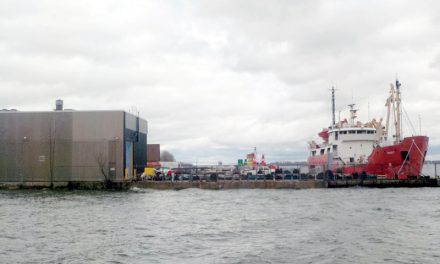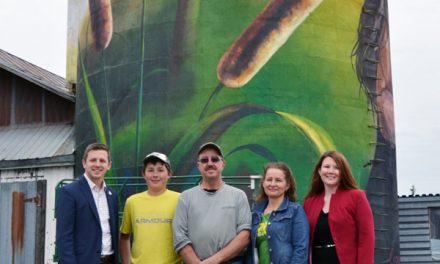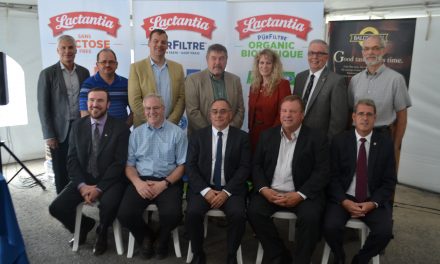Cory Davis, Sabanto product manager explains the Sabanto system which allows the Kubota M5 111 to be operated autonomously. Tinkess Photo
By Terry Tinkess
AgriNews Staff Writer
CHESTERVILLE – There were many excellent presentations at the 8th annual Great Ontario Yield Tour which made a stop at Derks elevator, south of Chesterville, Ontario on Thurs., Aug. 24, but one that drew a lot of attention was a Kubota M5 111 Tractor that was working without an operator.
The presentation was led by Jordan Wallace of Ontario GPS, who are in North Gower, Ontario. They are the local Sabanto dealer and offer Sabanto’s autonomy system that can be used to retrofit existing machinery.
“There’s a bunch of firsts here today,” said Wallace. “The Kubota M5 111 tractor behind us is the first aftermarket installed level five autonomous tractor in Canada. As of Saturday, this week, got it operational from the guys from Sabanto to come and give us a hand putting it in, get it in and get a certified trainer. So, Corey Davis is up here from Sabanto.
“It’s been pretty fun,” said Wallace. “We’ve done five demos with it so far in actual field applications. So, the first couple were just cutting hay, the first one was just cutting out the fields, and let them dry out. We went to Dave Gallinger’s in Winchester here, and while he was cutting with his tractor and New Holland, just fine, we were cutting up right behind them.
“The one man doing two jobs in Canada, was the premise that we were looking at, because labour’s kind of getting hard, and some of these easy jobs are kind of low hanging fruit for us to kind of look at. The next day we pulled in, hooked up a rake and we ran a B rake basically up the field fully autonomous. He pulled in 15 minutes later; he was bailing right behind us. Again, one driver, two tractors keeping everything rolling.”
According to Wallace, the installation is straight forward. They add two digital hydraulic valves so you can electronically control them from a computer or iPad. You’re in control of the throttle, the shuttle, rear three-point hitch, PTO, and all the sensors. There are two cameras on the front that are there for obstacle detection.
If something walks in front of it or drives in the front of it, or it’s going to drive into something, it stops,” said Wallace. “When you look at the screen there’s two boundaries, there’s basically a roadside field boundary and then there’s a geofence. And if the tractor is going across that geofence boundary, that kills it, it can’t drive away. If it loses cellular communication, it pauses until it gets it back. If it loses a GPS and pauses until it gets it back.”
As you might expect, the number of supported platforms is still a bit limited, but that will change in time. Right now, the two supported platforms are the M5 Kubota and the 700 series Gen6 Fendt. “We’re tied right into the vehicle ECU, right so everybody’s got their own communication types and languages,” said Wallace. There’s no connector and the market isn’t really standardized today.
“They all have their own language, we have to figure it all out, and get it integrated.”
According to Wallace it is understood that it will take time. “We know we’re going to walk before we run into a lot of a planting and running a baler, even until we can get some sensor integration.
“We have a really smart tractor, but we got a lot of really dumb implements. Until we can get the implements to be smart, as well as the tractor, it’s going to be a challenge in some of these scenarios.”
Cory Davis is a product manager with Sabanto, an agriculture technology company that specializes in autonomous operation. He spoke about the retrofitting of the Kubota tractor that was on display.
“We try and keep it looking as OEM as we possibly can. The whole thing, I think, there’s two holes you have to drill, everything else is able to use existing locations. You want to make it as seamless as possible,” said Davis. He still finds the technology amazing.
“You see the thing running,” said Davis. “I’ve seen it where we’ve [got] a fuel tank on that thing and it will run for, I think, eight-nine hours, straight through the night and the problem is people have got to get used to not seeing an operator. It can be scary, [for some it’s] a big culture shock, that’s for sure.”
One obvious advantage is that with a human operator, you must train the individual, and sometimes retrain them. If they leave for greener pastures, then you must train someone new, and the cycle continues. With an autonomous tractor, you “train it” once.
As well, with human operators, even someone who is truly proficient, all it takes is a moment’s inattention for something bad to happen. All the built-in safety features in the autonomous machine help to reduce that from happening. If the signal drops, the machine stops. If it meets an obstruction, it stops, if it gets stuck, it stops before additional problems can be created.
And while this approach may seem to eliminate some positions, Davis says it also can create new ones as well. “This technology offers new job opportunity for people if they want to be that person to train others,” says Davis. “So, as a farmer, or somebody using the equipment, you can just press a button and let it do its thing. You didn’t do it, but you can learn how to set it up, program it too. It’s really user friendly.”
For more information on Sabanto autonomous systems or any other service that GPS Ontario offers, you can visit their website at www.gpsontario.ca or give them a call at 613-489-2932.













